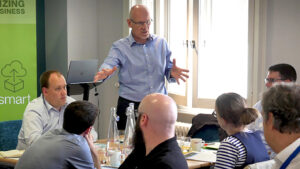Digital by Default Webinar: Your Questions Answered
As a follow up to our Webinar: Digital by Default: New ways of working, here are all the questions that were asked at the end of the session. We really appreciate everyones attendance and participation during this event, and hope you find the information here valuable. Make sure to register for part two of this webinar series; Modernisation of ECM in Government.
Q1. Is there any retention applied to documents held in the sharing area?
Jeff Nott: Configurable Retention (and Disposition) is a feature of the Alfresco Records Management add-on product which runs integral to the Alfresco One product. More info is available at this page: https://www.alfresco.com/products/records-management and there’s a demo of the scheduling at this page http://docs.alfresco.com/rm2.3/concepts/rm-tutorials-04.html. There is also the Lifecycle Management features in the core Alfresco One product (recorded demo at this page, please accept our apologies for the poor quality sound: https://www.youtube.com/watch?v=PHWwoe75Jzc). Both Retention and Lifecycle are able to be applied to documents held in the sharing area.
Q2. Can you manage CAD files?
Jeff Nott: The Alfresco repository is able to manage any electronic file type. Some formats may not be able to benefit from all the features Alfresco provides for the most popular formats such as MS Office and PDF such as previewing. As CAD files are generally complex in structure I would suggest taking a look at the add-on product from Alfresco technology partner Formtek: https://www.alfresco.com/partners/solutions/formtek-engineering-data-management. If you have a sample CAD file we can take a look and let you know what core functionality is available.
Q3. Can you manage video files in Alfresco?
Jeff Nott: Yes is the answer! Alfresco stores the content files it is managing on the file system (unlike some systems which store the file in the database). This means there is no restriction on the size of file that Alfresco can manage and also means that features such as lower cost storage can be used in conjunction with the Lifecycle Management.
There is also the Alfresco Media Management module which is designed to make it easier for companies to store and manage a range of rich media files, such as high definition video, without a separate system. The new components allow end users to view, conduct lightweight editing and transforming of photos and videos within our platform, removing the requirement to download the files and use specialist media editing or viewing software. This saves serious time and removes complexity. It also makes it easier transcoding video files from one format to another (HD to mobile or streaming formats) or to transform media files from one format to another – for example transforming high-quality print-ready images to lower resolution for inclusion on a company’s website. This new media-handling component enables companies to easily repurpose rich media files to further drive digital business.
Q4. Does Alfresco have connectors into other SAN/unstructured data and can it then manage retention disposal and audit?
Sergio Rojas: Audit and Retention disposal yes. About the connectors, it is better to send us the specific scenario so we can provide a better answer.
Q5. Does the solution need that 2 instance configuration, why not just 1 that’s accessible if allowed?
Sergio Rojas: The reason of having two instances is because the Internal users sit inside a protected Government network that does not allow External users access. Only the required information is synced with the External instance in a controlled and very secure way.
Q6. So for OFFICAL information, it could be possible? (where we don’t need the higher level of security associated with OFFICIAL information)
Sergio Rojas: Yes, whenever the information sits outside of a government protected network
Q7. Is there a ‘cloud’ version available to save Departments needing to build their own instances?
Jeff Nott: Alfresco is browser-based with no footprint on the desktop which allows Alfresco customers to decide where it suits them to install the repository and Alfresco engine. Taking the Digital Marketplace / G-Cloud as an example there are various options that range from a full managed service as per the EDRM solution Zaizi are providing to BIS (Business, Innovation & Skills) through to implementing Alfresco on existing Cloud-based infrastructure. You can get a taster of Alfresco running in the Cloud via the “On-line” trial where all you need is a web browser: https://www.alfresco.com/products/one/trial/online
Q8. I am looking at other options to SharePoint that is being introduced to some departments. I’m not experienced in either, so I would be interested in similarities should we move to Alfresco
Jeff Nott: Both are very large as far as features are concerned and whilst I don’t have a list of similarities you may find it interesting to take a look at the numerous feature videos at this page: http://docs.alfresco.com/5.0/topics/alfresco-video-tutorials.html. We can also give you some more specific insights relevant to your own use case if you’d like to make contact.
Q9. Can a business analyst design their own workflows?
Jeff Nott: The Alfresco Activiti “Kick-start” provides a suite of business analyst -friendly tools to model and deploy business processes. These are:
- Step Editor to guide business users through the creation of a new process model
- BPMN Editor for dedicated BPM analysts to create powerful process models
- Drag and drop Forms Editor to capture business data
- Forms Library to share and reuse forms across processes
Watch the webinar

